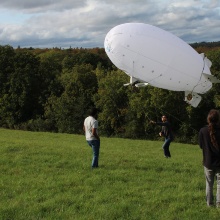Motivation
Lighter-than-air vehicles (LTAVs) such as rigid and nonrigid dirigibles, or airships, are clearly a superior choice for some applications like wildlife monitoring, sports event capture and continuous patrolling of forest regions for anti-poaching tasks. LTAVs are uniquely suited as aerial communication relays, for wildlife monitoring and conservation tasks, which we address in one of our other projects, WildCap. Airships produce little noise, have high energy efficiency and long flight times, display benign collision and crash characteristics, pose low danger and cause little environmental impact. However, their comparably high handling complexity, size, lifting gas requirements and cost create an entry barrier for researchers. Unlike for heavier-than-air drones, there have been no off the shelf flight controllers that support autonomous dirigible flight. Therefore, guidance and control algorithms have to be implemented for each vehicle - even though various suitable control strategies can be found in the literature. Similar to both rotor craft and fixed wing UAVs, dirigibles come in many types of actuator arrangements: Fixed or vectoring main thrusters, differential thrust, different tail fin arrangements and auxiliary thrusters, single or double hull, etc. Thus, a control algorithm for a specific vehicle might not always be applicable to others.
Methodology
Fixed wing and multirotor UAVs are common in the field of robotics. Solutions for simulation and control of these vehicles are ubiquitous. This is not the case for airships, a simulation of which needs to address unique properties, i) dynamic deformation in response to aerodynamic and control forces, ii) high susceptibility to wind and turbulence at low airspeed, and iii) high variability in airship designs regarding placement, direction and vectoring of thrusters and control surfaces. In our most recent work [1] , we are designing a flexible framework for modeling, simulation and control of airships, based on the Robot operating system (ROS), simulation environment (Gazebo) and commercial off the shelf (COTS) electronics, all of which are open source. Based on simulated wind and deformation, we predict substantial effects on controllability, verified in real world flight experiments. All our code is shared as open source, for the benefit of the community and to facilitate lighter-than-air vehicle (LTAV) research. It can be found here (https://github.com/robot-perception-group/airship_simulation)
In addition to the classical methods, we are also investigating reinforcement learning based approaches for autonomous control of airships. Airships' dynamics are complex. Due to its size, the air drag on its body is huge which leads to significant time-delay and higher sensitivity to disturbance. The size and shape of an airship depend on the properties of the surrounding air. Change in the environment often leads to blimp deformation and buoyancy change. Furthermore, the airship often has no direct control over its lateral movement. Our insight is that the lateral error can be compensated by sophisticated long-term planning. Therefore, one of our goals in this project is to derive a robust control policy that can handle such complex dynamics and still achieve high performance.
Goals and Tasks
In project AeRoShip our goal is to develop a team autonomous airships which is capable of monitoring wildlife for long durations.
To this end, our objectives are
- To develop robotic airship hardware and flight control methods.
- To develop novel planning and navigation methods for single and multiple airships performing visual monitoring in an obstacle-rich environment.
Publications
[1] Price, E., Liu, Y. T., Black, M. J., & Ahmad, A. (2022). Simulation and Control of Deformable Autonomous Airships in Turbulent Wind. In M. H. Ang Jr, H. Asama, W. Lin, & S. Foong (Hrsg.), Intelligent Autonomous Systems 16 (S. 608--626). Springer International Publishing. https://doi.org/10.1007/978-3-030-95892-3_46
[2] Liu, Y.T., Price, E., Black, M.J., Ahmad, A. (2022) Deep Residual Reinforcement Learning based Autonomous Blimp Control, Accepted to IEEE/RSJ International Conference on Intelligent Robots and Systems (IROS), 2022.

Aamir Ahmad
Jun.-Prof. Dr.-Ing.Deputy Director (Research)

Yu-Tang Liu
M. Sc.



